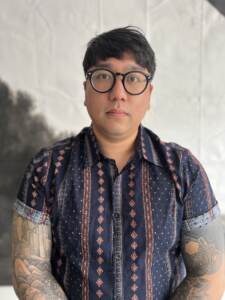
 i_need_contribute
i_need_contribute
 Acupuncturist Toto Cheng performs acupuncture on an athlete. (Lin Tin Nok/WHYY)
Acupuncturist Toto Cheng performs acupuncture on an athlete. (Lin Tin Nok/WHYY)
When Tyler Phan was 17, he went to visit his relatives in Vietnam during the summer. He has asthma. It was hotter and more humid in Vietnam than in western Pennsylvania where he lived — which made his asthma worse.
His grand uncle gave him a quick lesson in acupuncture. Then he handed Phan the needles. Phan put needles in his forearm, which hurt but also made him feel better. It was “almost … an instantaneous relief in my breathing,” Phan said.
His mother told him this medicine is a family tradition, passed down through generations. She introduced him to acupuncturists who work at hospitals in Vietnam that were connected to Buddhist monasteries that serve the poor. Phan became an apprentice and started doing acupuncture.
Phan really liked the DIY aspect of acupuncture, and thinks it appealed to him because he was also into punk rock.
“The unique thing about acupuncture is that you can needle yourself,” Phan said. “It gives you this great sense of autonomy and it gives you a sense of self-empowerment.”
After spending a few summers in Vietnam, he decided to pursue acupuncture as a career. But he knew that if he wanted to practice in the U.S. he had to get credentials at an acupuncture school. He attended a four-year program at a school in North Carolina.
On the very first day of class, Phan’s instructor told him, “if you are needling someone without a license, that you are doing something illegal.”
“And I don’t know if it was me being young, 19 at the time, or being punk rock. I immediately questioned why.”

Acupuncturist Tyler Phan said he was confused by how acupuncture schools and national board exams teach different approaches to acupuncture. (Courtesy of Nikie Belliveau)
The acupuncture school also taught a much different philosophy than what he had grown up with. He learned that if somebody has pain in one area — the needles should go into another body part that is similar. For example, if someone had left knee pain, the acupuncturist would put the needles in a part of the body that looks like a knee but is not a knee, like the right elbow.
But at school, he learned a mixture of Chinese and Japanese traditions, translated from the point of view of British and French practitioners. Then, he prepared for the national board exams, which tested students on standardized practices from 1950s China.
“A lot of the students were completely in dismay because they had to relearn a completely other set of Chinese medicine.”
Phan was confused by all of these different requirements. He wondered: Who gets to decide on these standards in the U.S.? What should be taught in acupuncture schools? And why is it so different from what he learned?
“It seemed a little bit arbitrary and baffling to standardize these disparate practices,” he said.
Phan got a master’s degree, and a PhD to answer those questions. For his PhD research, he traveled across the U.S. to find out how different acupuncture schools treated patients in their clinics and what type of acupuncture they were using.
None of the schools wanted to work with him, so he went undercover as a patient. He went to clinics in Oregon, California, New Mexico, Florida, North Carolina, and Pennsylvania. He had shingles at the time, and pain in his left shoulder. He wanted to see what practitioners at different clinics would do with the same set of symptoms.
He was treated sometimes with regular acupuncture, sometimes with electroacupuncture, sometimes with tuning forks. Some clinics talked to him about his health history for 15 minutes; while another interviewed him for 2 ½ hours.
He says he felt better, to varying degrees, after all of the treatments he received, so he did not come away thinking any one approach was better than the other.